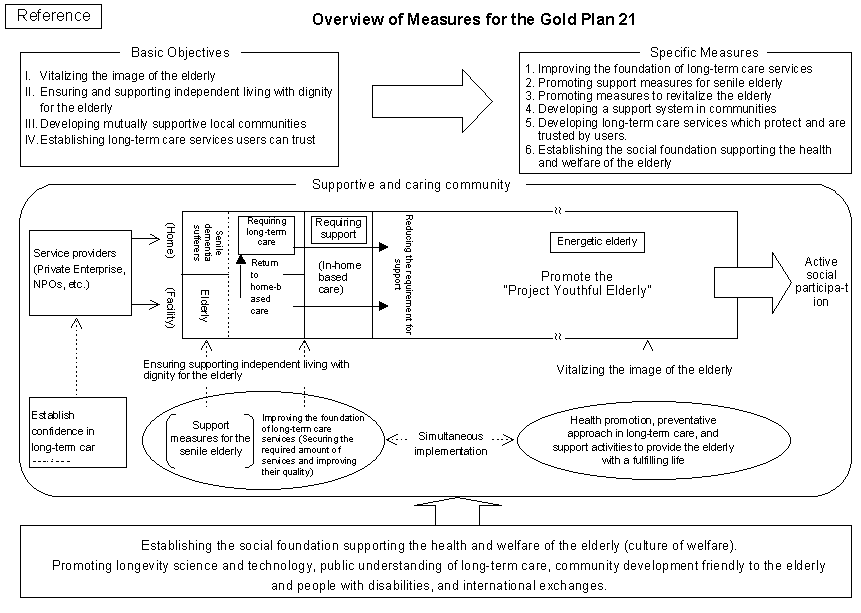
|
Direction of Health and Welfare Policies for the Elderly over the Next Five Years −Gold Plan 21− |
With the aging rate of the Japanese population set to reach the world's highest standard in 2000, a new plan has been devised to further improve the health and welfare policies for the elderly.
(1) Basic direction of the plan
(Basic objectives)
| I. | Vitalizing the image of the elderly The 21st century is the "century of the elderly". To build a brighter and energetic society, we must "vitalize the image of the elderly", helping as many senior citizens as possible socially participate in good health and a positive attitude to life. |
| II. | Ensuring and supporting the independent living with dignity for the elderly In order to help the elderly, in need of support, lead an independent life with dignity, and to support their families providing such care, we must define home-base care as the basic form of living for the elderly, and improve the foundation of long-term care services both qualitatively and quantitatively. |
| III. | Developing mutually supportive local communities In order to develop community-based support systems covering not only long-term care, but also all aspects of life, we must actively work toward developing local communities where residents can support each other, and improving the living environment for the elderly. |
| IV. | Establishing long-term care services users can trust In order to establish a user-oriented mechanism in the transition from cares given by the government to cares chosen by users, we must improve the environment for user protection and make a healthy development of long-term care services, with the aim of establishing user confidence in such services. |
(Period of the Plan)
(2) Specific measures to be implemented in the future
Efforts will be made to adequately implement the following projects, with a view to improve the foundation of long-term care services and provide living support measures, etc. at the same time. Support will also be extended to voluntary projects conducted by regional governments.
| 1) | Improving the foundation of long-term care services "Long-term care services available whenever and wherever"
|
| 2) | Promoting support measures for the senile elderly "Building a society where the elderly can live with dignity"
|
| 3) | Promoting measures to revitalize the elderly "Implementation of the 'Project Youthful Elderly'"
|
| 4) | Developing a support system in communities "Creation of supportive and caring communities"
|
| 5) | Developing long-term care services which protect and are trusted by users. "Creating services which one can choose with confidence"
|
| 6) | Establishing a social foundation supporting the health and welfare of the elderly "Laying the foundation supporting health and welfare"
|
(3) Amount of long-term care services provided in the fiscal 2004
Under the Long-Term Care Insurance program, each local government estimates the amount of long-term care services available in the future. The following tables show the estimated amount of long-term care services in the fiscal year 2004:
(Home-visit services)
| Category | (New Gold Plan target) | |
| FY 1999 | FY 2004 | |
| Home-visit long-term care | − | 225 million hours |
| (home help services) | 170,000 people | (350,000 people)* |
| Home-visit nursing care | − | 44 million hours |
| Home-visit nursing care stations | 5,000 facilities | (9,900 facilities)* |
(Commuting-type)
| Commuting long-term care (Day service) | − | 105 million visits |
| Commuting rehabilitation (Day care) | 17,000 facilities | (26,000 facilities)* |
(Short-stay-type services)
| Short-term stay at care facility / Medical care service through a short-term stay |
− For 60,000 people (beds exclusive for short stay) |
4,785,000 weeks For 96,000 people (beds exclusive for short-term stay at care facility nursing care) |
(Facility-type services)
| Welfare facilities for the elderly requiring long-term care (Special home for the elderly) | For 290,000 people | For 360,000 people |
| Health care facilities for the elderly requiring long-term care | For 280,000 people | For 297,000 people |
(Living support-type services)
| Daily life care in communal living for the elderly of dementia (Group home for the elderly with dementia) | − | 3,200 facilities |
| Low-cost home for the elderly with long-term care services (Care house) | For 100,000 people | For 105,000 people |
| Center for the life and welfare of the elderly | 400 facilities | 1,800 facilities |
| Notes 1: | The figures in brackets for the fiscal year 2004 are estimations calculated on set premises. |
| 2: | Sanatorium type medical care facilities for the elderly requiring care are designated by prefectural governors, upon application from sanatorium type wards. |
